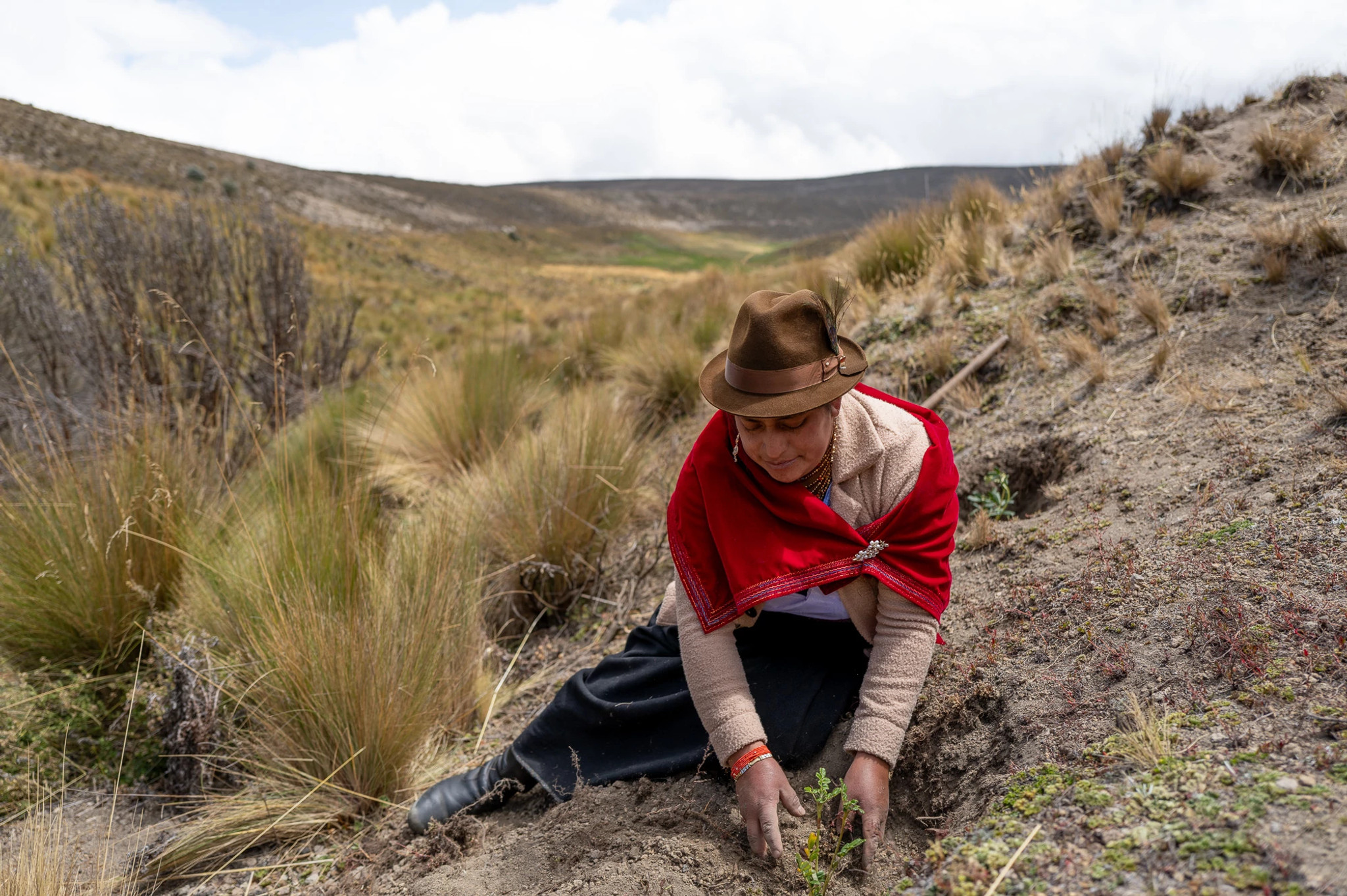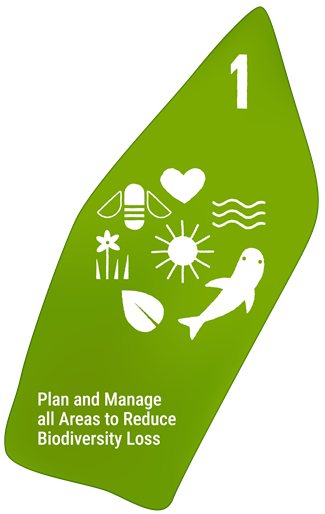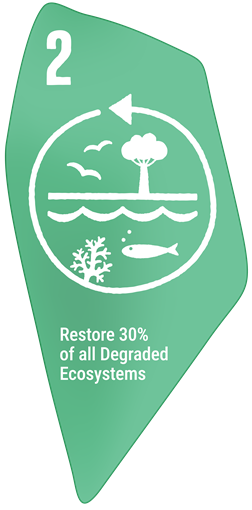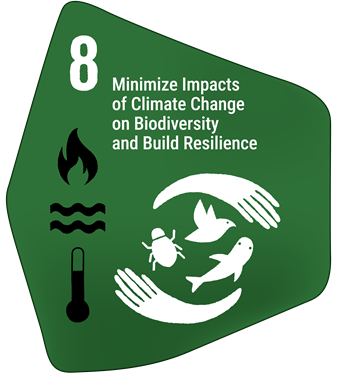 UNEP/Todd Brown
UNEP/Todd Brown
World Environment Day-- 5 June 2024
Land ecosystems provide invaluable services that are essential for life, such as oxygen, food and water.
Land is also critical to our efforts to address climate change and to protect us from its worst impacts.
And land is home to much of the world’s biodiversity:
- The forests, the plains and the meadows host an extraordinary wealth of life forms.
- Soils teem with invertebrates and microorganisms working day and night to support life and our very existence on this planet.
But land degradation through deforestation, desertification, pollution and waste, and climate change, are stifling land ecosystems, putting millions of people in harm’s way.
We need to restore land and its ecosystem functions and services.
The Kunming-Montreal Global Biodiversity Framework—also known as The Biodiversity Plan—is about halting and reversing biodiversity loss by 2030 for the benefit of people and planet.
This is humanity’s roadmap towards living in harmony with nature.
The four goals of the plan aim to protect and restore nature, to prosper with nature, to share benefits fairly, and to invest and collaborate for nature.
The Plan includes a specific target to restore 30% of all degraded ecosystems by 2030. Other Targets address land use-planning, sustainable agriculture, urban planning and reducing the risks from pollution.
Achieving the ambitious goals and targets of the Plan requires a whole of society approach, with the active participation of indigenous peoples and local communities, women and youth, business and civil society and all levels of government.
We must all be part of the Plan. We must all be part of Generation Restoration.
Happy #WorldEnvironmentDay!
— UN Biodiversity (@UNBiodiversity) June 5, 2024
Join #GenerationRestoration and millions around the globe to take action to restore our land & soil!
Read our web story: https://t.co/xfVGv7PqJO
Watch a message from our Acting Executive Secretary @hdavidcooper 👇 pic.twitter.com/bmGADDhXs7
More information:
Dry and Sub-humid Lands Biodiversity
Related Targets in The Biodiversity Plan
Ensure that all areas are under participatory, integrated and biodiversity inclusive spatial planning and/or effective management processes addressing land- and sea‑use change, to bring the loss of areas of high biodiversity importance, including ecosystems of high ecological integrity, close to zero by 2030, while respecting the rights of indigenous peoples and local communities.
Why is this target important?
Land-use and sea-use change are major direct drivers of biodiversity loss. Land-use change has had the largest relative negative impact on terrestrial and freshwater ecosystems since 1970, with agricultural expansion being the most widespread form of land-use change. Marine and coastal ecosystems have been significantly affected by human activities as well, with research demonstrating increasing cumulative impacts of human activities in more than 60 per cent of the ocean.
Increasing demands and conflicting uses of land, inland water and ocean space and resources underscore the need for cross-sectoral approaches that allow for the consideration of multiple interests, values and types of use. Integrated spatial planning and/or effective management processes allow countries to analyze and then effectively allocate the spatial and temporal distribution of activities in each environment to achieve various social, ecological and economic objectives. Integrated and participatory spatial planning helps bring together all stakeholders for a particular space and thereby ensure the prioritization and proper allocation of various activities and thereby balance the need to safeguard nature, while advancing sustainable socioeconomic development and ensuring food security and human well-being. The ecosystem approach as well as the many examples of guidance and experience in implementing this approach also provide a strong basis for this target.
Links to other elements of the Biodiversity Plan and other frameworks and processes.
- Actions to reach Target 1 should take into account all of the considerations for implementation identified in section C of the Kunming-Montreal Global Biodiversity Framework.
- Progress towards this target will support the attainment of goals A and B of the Kunming-Montreal Global Biodiversity Framework. In addition, progress towards this target will directly support the attainment of targets 2, 3, 5, 10 and 12 of the Framework. Conversely, progress towards targets 14, 19, 20, 21, 22 and 23 will help to reach Target 1.
- Target 1 addresses issues that were previously addressed by Aichi Biodiversity Target 5.
- Elements of Target 1 are also addressed in the targets of the Sustainable Development Goals, including targets 14.2, 15.1, 15.2, 15.5 and 15.9.

Ensure that by 2030 at least 30 per cent of areas of degraded terrestrial, inland water, and coastal and marine ecosystems are under effective restoration, in order to enhance biodiversity and ecosystem functions and services, ecological integrity and connectivity.
Why is this target important?
Habitat degradation is the result of human-induced processes that result in a decline in biodiversity, ecosystem functions and services, and resilience and can occur in terrestrial, freshwater or marine and coastal ecosystems. Because degradation can take many forms and be measured in different ways, there are varying estimates on the amount of degraded habitat globally. However, estimates suggest that between 20 and 40 per cent of the global land area alone could be considered degraded, affecting the well-being of at least 3.2 billion people
The main direct drivers of land degradation are the expansion of crop and grazing lands into natural areas, unsustainable agricultural and forestry practices, climate change, and, in specific areas, urban expansion, infrastructure development and extractive industry. Habitat loss through transformation and the decline in the suitability of the remaining habitat through degradation are the leading causes of biodiversity loss. Ecosystems affected by land degradation mainly include forests, rangelands and wetlands. Wetlands are particularly degraded, with 87 per cent lost globally in the last 300 years, and 54 per cent since 1900. Marine ecosystems are experiencing high rates of habitat loss and degradation as well, particularly along coastlines, mangrove forests and coral reefs.
Links to other elements of the Biodiversity Plan and other frameworks and processes.
- Actions to reach Target 2 should take into account all of the considerations for implementation identified in section C of the Kunming-Montreal Global Biodiversity Framework.
- Progress towards this target will support the attainment of goals A and B of the Kunming-Montreal Global Biodiversity Framework. In addition, progress towards this target will directly support the attainment of targets 3, 8, 11 and 12 of the Framework. Conversely, progress towards targets 1, 14, 19, 20, 21, 22 and 23 will help to reach Target 2.
- Target 2 addresses issues that were previously addressed by Aichi Biodiversity Target 15
- Elements of Target 2 are also addressed in the targets of the Sustainable Development Goals, including targets 6.6, 14.2, 15.1 and 15.3
- Target 2 also links to processes under the United Nations Convention to Combat Desertification (UNCCD) related to land degradation neutrality and associated target setting, the Global Forest Goals and targets of the United Nations Strategic Plan for Forests developed under the United Nations Forum on Forests, Ramsar Resolution VII.17 as well as to the United Nations Decade on Ecosystem Restoration.

Ensure and enable that by 2030 at least 30 per cent of terrestrial and inland water areas, and of marine and coastal areas, especially areas of particular importance for biodiversity and ecosystem functions and services, are effectively conserved and managed through ecologically representative, well-connected and equitably governed systems of protected areas and other effective area-based conservation measures, recognizing indigenous and traditional territories, where applicable, and integrated into wider landscapes, seascapes and the ocean, while ensuring that any sustainable use, where appropriate in such areas, is fully consistent with conservation outcomes, recognizing and respecting the rights of indigenous peoples and local communities, including over their traditional territories.
Why is this target important?
Land-use and sea-use change are major direct drivers of biodiversity loss. Land-use change has had the largest relative negative impact on terrestrial and freshwater ecosystems since 1970, with agricultural expansion being the most widespread form of land-use change. Marine and coastal ecosystems have been significantly affected by human activities as well, with research demonstrating increasing cumulative impacts of human activities in more than 60 per cent of the ocean.
Increasing demands and conflicting uses of land, inland water and ocean space and resources underscore the need for cross-sectoral approaches that allow for the consideration of multiple interests, values and types of use. Integrated spatial planning and/or effective management processes allow countries to analyze and then effectively allocate the spatial and temporal distribution of activities in each environment to achieve various social, ecological and economic objectives. Integrated and participatory spatial planning helps bring together all stakeholders for a particular space and thereby ensure the prioritization and proper allocation of various activities and thereby balance the need to safeguard nature, while advancing sustainable socioeconomic development and ensuring food security and human well-being. The ecosystem approach as well as the many examples of guidance and experience in implementing this approach also provide a strong basis for this target.
Links to other elements of the Biodiversity Plan and other frameworks and processes.
- Actions to reach Target 1 should take into account all of the considerations for implementation identified in section C of the Kunming-Montreal Global Biodiversity Framework.
- Progress towards this target will support the attainment of goals A and B of the Kunming-Montreal Global Biodiversity Framework. In addition, progress towards this target will directly support the attainment of targets 2, 3, 5, 10 and 12 of the Framework. Conversely, progress towards targets 14, 19, 20, 21, 22 and 23 will help to reach Target 1.
- Target 1 addresses issues that were previously addressed by Aichi Biodiversity Target 5.
- Elements of Target 1 are also addressed in the targets of the Sustainable Development Goals, including targets 14.2, 15.1, 15.2, 15.5 and 15.9.

Minimize the impact of climate change and ocean acidification on biodiversity and increase its resilience through mitigation, adaptation, and disaster risk reduction actions, including through nature-based solution and/or ecosystem-based approaches, while minimizing negative and fostering positive impacts of climate action on biodiversity.
Why is this target important?
Climate change is one of the main direct drivers of biodiversity loss. In addition to climate change, rising atmospheric carbon dioxide concentrations have also resulted in ocean acidification. Various mitigation, adaptation and disaster risk reduction measures, including nature-based solutions and/or ecosystem-based approaches, have the potential to increase the resilience of ecosystems and human livelihoods to the impacts of climate change, including reducing emissions from deforestation and other land-use changes, and by enhancing carbon sinks. These approaches can also deliver numerous social, economic and environmental co-benefits.
Links to other elements of the Biodiversity Plan and other frameworks and processes.
- Actions to reach Target 8 should take into account all of the considerations for implementation identified in section C of the Kunming-Montreal Global Biodiversity Framework.
- Progress towards Target 8 will help to reach goals A and B of the Kunming-Montreal Global Biodiversity Framework. Progress towards this target could also help to reach targets 2, 3, 4, 10, 11, and 12. Conversely, progress towards targets 1, 10, 14, 19, 20, 21, 22 and 23 would facilitate progress towards this target.
- Target 8 addresses issues previously addressed in Aichi Biodiversity Target 10.
- Elements of Target 8 are also addressed in the targets of the Sustainable Development Goals, including targets 13.1, 13.2 and 14.3.
- Target 8 is also relevant to work being undertaken under the Paris Agreement under the UNFCCC, as well as the Sendai Framework for Disaster Risk Reduction.
